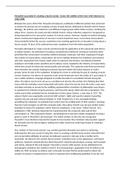Mussolini succeeded in creating a fascist society. Assess the validity of this view with reference to
1922-1940.
Between the years 1922-1940, Mussolini introduced a multitude of different policies that all strived
to achieve his primary aim of creating a society of loyal fascists, dedicated to himself and the Fascist
ideology. His policies were tailored to suit different target groups within Italian society, including the
labour force, women, the youth and the Catholic Church, whose collective support he recognised as
being imperative to the successful creation of a fascist society. However, despite his policies bringing
about a surface-level appearance of success in several important areas, it was these same policies
that essentially limited his success, sometimes even working against him on his path to bring about a
fascist society. At best, all he achieved was tacit compliance from the Italian population.
Mussolini attempted to create a fascist society through his application of the corporate state theory
to Italian industry. He advertised it as being a revolutionary method of running an economy which
prioritised the nurturement of positive relations between employers and their employees through
the creation of corporations. Corporations set out to mediate between the employers and workers
and each corporation had a fascist trade union to represent the workers; any disputes between
employers and trade unions would be sent to labour courts, headed by the Ministry of Corporations,
where they would (in theory) be solved quickly and amicably. The corporate state theory presented
how Mussolini was actively working to promote harmony within the Italian industry to instil a
greater sense of unity in the workplace, bringing him closer to achieving his goal of creating a fascist
society. However, the theory of corporate state varied immensely from the reality of it- put simply, it
was a public relations campaign designed to enable Mussolini to consolidate himself among the
elites. The labour courts were set up as a semblance to deceive the workers into thinking that their
issues with the workplace were being dealt with justly, when this was far from the truth; cases were
not taken seriously as proven by the unfitting representation of workers (a philosopher was chosen
to represent the interests of grain growers), and Mussolini always sided with the corporations. This
reality was further embodied by the introduction of the Labour Charter, a year later in 1927. The
Labour Charter was supposedly concerned with workers’ rights and was the catalyst in granting
workers sick pay and paid national holidays in 1938. Despite this, it was not legally binding,
permitting the employers to maintain their control over the entitlements of their workers, meaning
that not much changed. As with the corporate state, the Labour Charter was yet just another policy
intended to favour the employers rather than the employees. In his novel, ‘Italian Fascism’, first
published in 1982, historian Alexander De Grand describes the corporate state and all that
surrounded it as ‘The Corporative Illusion’, presenting how it has been widely recognised as being a
guise to assist in Mussolini’s personal gain. The Italian workers at the time also recognised
Mussolini’s true intentions beyond the façade he had created, this revelation reducing their support
for Mussolini and his fascist regime, setting him further away from achieving his goal of creating a
fascist society.
The creation of ‘the fascist woman’ was another goal that Mussolini was intent on achieving,
believing that this was crucial to bring him closer to creating a wholly fascist society. Mussolini held
very conservative attitudes to women. He believed a woman’s role was to be a mother and a
housewife. His ideas for the ‘perfect fascist woman’ extended as far as her appearance; anti-fascist
politician, Salvemini sardonically described Mussolini’s ideal female physique as being ‘well-rounded
and sturdy, instead of thin and elegant. Mussolini’s concern with women can be attributed to his
demographic ambitions (his ‘battle for births’) of increasing Italy’s population from 40 million to 60
million by 1950. He knew to achieve such a dramatic increase that he would need to reduce the
number of women in employment in order to maximise their childbearing potential. From the mid-





